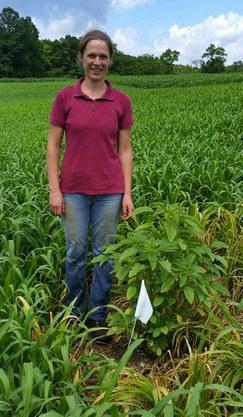Hopefully, most of our full-season soybean crop has been managed for weeds by this time of the summer and some growers have planted or are still considering double-crop. There is still time to ensure your soybean weed control programs worked by scouting those full-season soybeans for escapes and by selecting effective herbicides to control weeds in double-crop soybeans.

Former Penn State Field & Forage Educator Eli Snyder discovers glyphosate resist. Palmer Amaranth growing in several crops in late June. This plant was treated with glyphosate approx. one week prior to this photo. Image taken by Dr. Greg Roth 7/7/14
In particular, be on the look out for Palmer amaranth. We have talked a great deal about this weed over the last year, and most of our Pennsylvania Palmer amaranth infestations last fall were discovered in soybeans (both full-season and double-crop). Containing new infestations and preventing the spread is a critical first step to managing this new threat.
Seeds collected from southeastern PA fields last fall were tested in a greenhouse assay this winter and showed that all five populations were resistant to glyphosate, and four of five were resistant to both glyphosate and the ALS inhibitors. In soybean fields, it should become quite obvious when resistant plants appear above the soybean canopy, but you have to scout those fields to find these escapes.
As stated in the Take Action Herbicide-Resistance Management Fact Sheet: Palmer Amaranth Management in Soybeans, proper timing is everything for effective control. In full-season soybeans, Palmer amaranth is already likely too big for traditional control measures, as effective post-emergence soybean herbicides should be applied before Palmer amaranth is 3 inches tall for best control. But better late than never, and over the next week or so will be optimal for control in double-crop.
The Group 14 (Flexstar/Reflex, Cobra/Phoenix, or Ultra Blazer) herbicides are some of the most effective. If you are fortunate enough to have LibertyLink soybeans, use a minimum rate of 29 fluid ounces per acre of Liberty. Spray coverage is essential with any of these herbicides, so a minimum of 15 gallons per acre of spray solution should be used. Once Palmer amaranth plants exceed 3 inches tall, control with any of these post-emergence herbicides is substantially reduced.
So scout those soybean fields now and do what it takes to control Palmer amaranth. Some attention now will ensure you’re not forced to attempt some last chance rescue (or field destruction) in September when Palmer amaranth is six feet tall or higher and flowering, or worse yet, has already produced seed.





